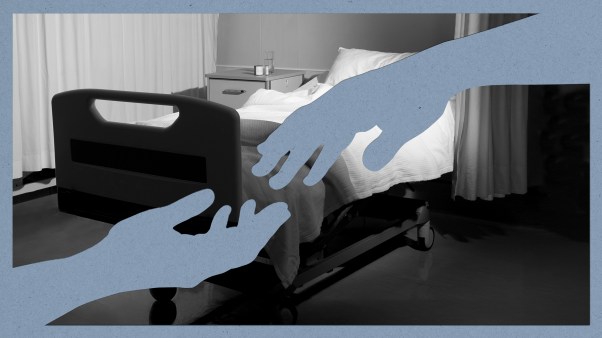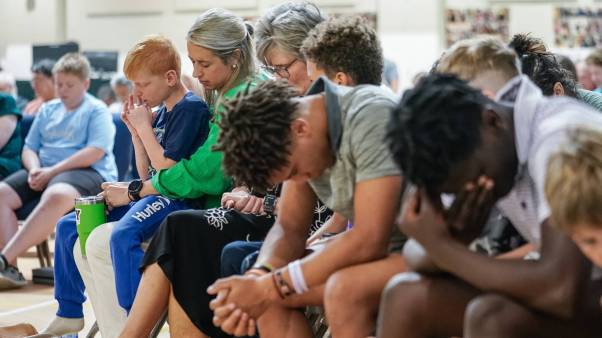Pam was a straight-A student, president of the church youth group, and a top competitor in state track.
Just a year before graduation, however, her parents found her dead in the car, the exhaust pipe stuffed with rags.
Pam’s bewildering actions illustrate a raging American epidemic: suicide. The problem is increasing especially among teenagers. For those fifteen to nineteen years old, suicide is the second leading cause of death; since 1955, it has increased 300 percent. Even more alarming is the number of children younger than fifteen who kill themselves. In 1950, forty committed suicide; in 1985, three hundred did.
One week after delivering a sermon on hope in a world of growing despair, Herbert W. Chilstrom, bishop of the Minnesota Synod for the Lutheran Church in America, found a family member had lost all hope. His son Andrew, eighteen, shot himself to death.
Suicide grimly reminds us all is not well in the world, and this is where a pastor has much to offer-hope and meaning for those who feel life has none.
Yet suicide is rarely addressed; it’s a topic none of us likes to talk about. Even in schools, the problem is not often discussed, except in those that have experienced cluster suicides (where one suicide triggers three or four more), like the ones in Plano, Texas; Westchester County, New York; and New Tner High School near Chicago.
As a result, when a parishioner commits suicide, pastors and congregations alike may not know how to respond to the family and friends of the victim. And when a teenager from the church is contemplating suicide, we may not recognize the signals or know how to offer help.
The first step toward helping people of course, is spending time with them and beginning to understand them. When trying to reach teens, Friday night basketball games may seem trivial to us, but they’re important to young people. They need to talk about their hair, their grades, and their weight, because these issues matter to them.
I wanted to minister to potential suicides, and in the suicide counseling courses I took, we spent weeks learning how to listen and developing the skills to be more sensitive. We learned that four out of five people thinking about suicide will drop hints that they need and want help. Based on information from the Suicide Prevention and Crisis Center of San Mateo County, California, and the Boston-based Samaritans, a national suicide-prevention group, here are some of those warning signals.
Warning signals
Each symptom alone is only a sign of stress and may not mean the teenager is on the verge of committing suicide. But each should be taken seriously. L While teenagers frequently change their moods and activity levels, those contemplating suicide become depressed for long periods, and more of these symp-S toms become apparent.
Change in personality-the youth becomes withdrawn, sad, irritable, or apathetic.
Irrational outbursts-the teenager suddenly becomes quick-tempered, cries easily, or becomes easily upset by trivial occurrences.
Decline in performance-grades drop, the teen no longer wants to compete.
* Change in eating or sleeping habits-the teenager begins sleeping or eating markedly more or less.
Talk about suicide-the youth will say he or she feels worthless, that no one cares. He or she may even talk about death.
Lack of interest in activities or hobbies previously enjoyed.
Oifficulty in communicating even small talk.
Isolation, a loss of friends.
Obsessive worry about money, illness, or grades.
Giving away favorite, treasured items.
Alcohol or drug abuse-the teen will begin using these substances, or the addiction will grow worse.
Nagging lack of optimism-suicidal teenagers feel out of control and are usually extremely negative about life in general.
Lack of hope-the youth feels he or she has no future and no longer looks forward to upcoming events.
Recent loss-the teen has lost a job, a friend, self-confidence, or has suffered loss through death, divorce, or separation.
Enormous sense of unhappiness or depression.
Rigid thinking, tunnel vision-suicidal teenagers often view life as an either/or situation.
If a young person’s warning signals go unheeded, he or she may resort to drastic measures in order to get attention. In fact, some 90 percent of teenage suicides take place at home between 3 P.M. and midnight-the time and place a suicide attempt would most easily be discovered.
Counseling the suicidal person
Getting suicidal young people to share their feelings is vital. The specific problem that triggered the depression and suicidal thoughts is often buried beneath the terrible feelings the adolescent is experiencing.
When a teen’s concerns or problems are determined, they should never be dismissed, no matter how trivial they seem. One C + in gym class may not seem like much to an adult, but teenagers have committed suicide because of it. One boy shot himself after failing to make the soccer team.
A common temptation is to argue with the suicide contemplator and to find holes in his or her logic, but that rarely proves helpful. As a hot line counselor, I’ve found callers contemplating suicide can be difficult to talk to when they’re angry. One caller yelled, “What are you going to do about it?” after telling me he wanted to commit suicide. I was tempted to tell him to grow up, but instead I replied, “What would you want me to do about it?”
The key is to focus on the teenager’s feelings and not let him or her divert you from the issue. A frequent counterproductive diversion is debating the rightness of the act. The youth is usually overwhelmed with feelings of guilt, helplessness, and rejection; arguments only add to the load.
Discussing a teen’s past can open the doors for healing. At some time, he or she could cope. Discuss those times. Is this the first time he’s felt like a failure? Probably not. And if not, how did he cope before? A girl who didn’t make the cheerleading squad, for instance, may think her world has come to an end. Ask her about other times when she didn’t win. How did she feel when she didn’t make the swim team three years ago? Encourage her to view the cheerleading situation in the same way.
If a teenager is extremely depressed but has not expressed any suicidal thoughts ask directly if he or she is considering suicide. Talking about suicide will not plant any new ideas; instead, it will help him or her express those fearful thoughts. The youth may respond that she doesn’t feel like living anymore and that everyone would be better off without her.
This kind of talk about death or threats of suicide should be taken seriously. If a teenager admits having suicidal thoughts, press for specifics. How often has he or she thought about it? How would he or she do it? Where? Most suicidal teens feel no one cares, and asking these questions shows that you do. It also, in a gentle way, forces them to think through the implications of the decision.
The specific plans are usually violent. According to the American Association of Suicidology in Denver, 62 percent of fifteen- to twenty-four-year-olds who commit suicide shoot themselves. If the teenager does have a specific plan for carrying out suicide, he or she should not be left alone. A specific plan indicates the youth has already made the decision to commit suicide.
Paradoxically, when a teenager seems to be doing better, the danger of suicide may be greater. Severely depressed teens don’t have the ability to do everyday tasks, let alone kill themselves. But as the depression lifts, so does the inability to act on earlier suicide plans.
Counseling suicidal youth, as this illustrates, is complex, and prevention and treatment require long-term commitments. It would be easy for a pastor helping suicidal young people to become a full-time crisis counselor. So in many cases, pastors will want to take advantage of people who are trained solely to deal with crises like suicide, such as hospital psychiatrists and crisis counselors. The pastor’s role often centers, then, on listening well and knowing what resources are available when additional help is needed.
The American Association of Suicidology cites approximately two hundred suicide-prevention centers throughout the United States. The Yellow Pages list available local centers under “Suicide Prevention Services” or “Crisis Intervention Services.” If such services are not available in your community, national suicide-prevention associations (see box) can offer guidance and support. Also, many continuing education programs now offer courses in suicidal and crisis counseling.
Educating the congregation and community
One of the most helpful things pastors can do is to educate the congregation and community concerning the issue. Programs on suicide have been incorporated by some churches into their regular educational offerings. Steve Swanson, a ninth-grade confirmation teacher in Northfield, Minnesota, asked his students to list topics to discuss. To his surprise, five of the nine students wanted to discuss suicide. By giving teenagers instruction in dealing with pres sures, success and failure, self-esteem, and communication, churches can help prevent suicides.
William Wendt, an Episcopal priest in Washington, D.C., saw the issues of suicide and death were not being addressed in local schools, so he established the St. Francis Center. Center staff members teach courses in junior and senior high schools and offer workshops and group counseling to the bereaved.
After a young college man committed suicide, the Conference of Churches in Glastonbury, Connecticut, created a series of programs aimed at prevention. One program involved the play, “Quiet Cries,” in which three people contemplate suicide for various reasons. The play is open-ended, and afterward the audience discusses it. About two hundred teenagers and adults came, and during the following two weeks, more people began opening up and sharing their feelings.
St. Columban’s Church in Birmingham, Michigan, set up a program called “Touched by Suicide” for those who have been affected by suicide. The group, led by Father Jack Trese, deals with the problems all those touched by suicide face.
Sadly, St. Columban’s program, like the one in Connecticut, did not get started until a suicide had occurred. How much more effective is the program that begins before a church member commits suicide.
Don’t give up
No matter how hard we try, however, there will be times when we won’t be able to save someone. Pam was only one person I knew who committed suicide. Two years later, a friend’s brother shot himself, and last year my cousin tried taking her life.
“Nothing is perfect and works all the time,” says Bruce Benson, a Lutheran pastor at St. Olaf College who officiated at the funeral of a student who committed suicide. “But that doesn’t mean we give up. Open-heart surgery works most of the time, but it doesn’t work all the time. That doesn’t mean we stop doing open-heart surgery.”
Addressing the problem of suicide and helping suicidal teenagers can be exhausting and time consuming. Yet, by learning to listen for warning clues and addressing the underlying problems, we can touch young lives-before it’s too late.
-Jolene L. Roehlkepartain Chicago, Illinois
The good things which belong to prosperity are to be wished, but the good things which belong to adversity are to be admired.
-Seneca
WHERE TO FIND HELP
The following national suicide-prevention associations offer information and assistance:
American Association of Suicidology, 2429 South Ash, Denver, CO 80222
For clergy, psychologists, social workers, physicians, and other professionals who share interest in studying suicide prevention. Distributes information through programs and publications.
International Association for Suicide Prevention, Suicide Prevention and (crisis lLenter, 1811 Trousdale Drive, Burlingame, CA 94010
Provides information about suicide prevention and trains people. Membership is worldwide; the association is headquartered in Vienna, Austria.
National Committee on Youth Suicide Prevention, 666 Fifth Avenue, 23rd Floor, New York, NY 10103
Develops youth suicide prevention programs in local communities and provides information to increase public awareness of youth suicide.
National Save-A-Life League,
44520 Fourth Avenue, Suite MH3,
New York, NY 11220
An organization for professionals and trained volunteers focusing on the prevention of suicide. Works closely with more than one hundred crisis centers throughout the United States.
The Samaritans,
500 Commonwealth Avenue,
Kenmore Square,
Boston, MA 1)2215
An organization for people who volunteer their time to help the suicidal and lonely. Holds more than one hundred talks and workshops a year on suicide prevention for professionals and lay people.
Copyright © 1987 by the author or Christianity Today/Leadership Journal. Click here for reprint information on Leadership Journal.









